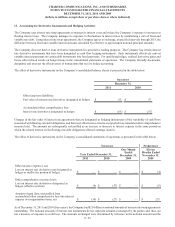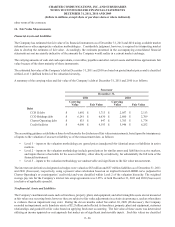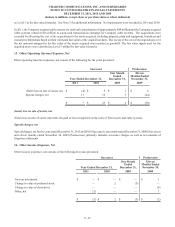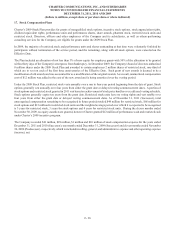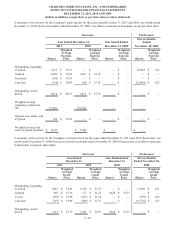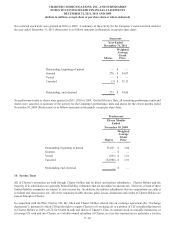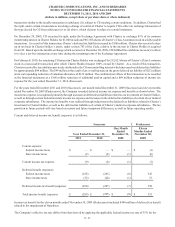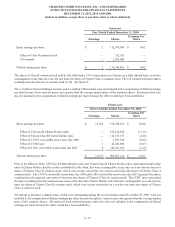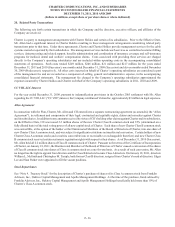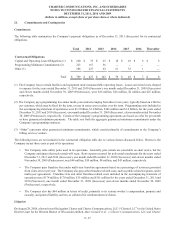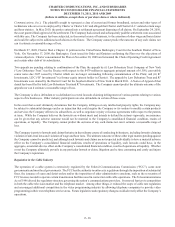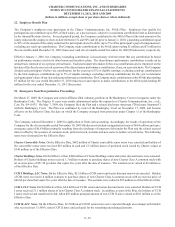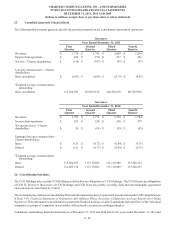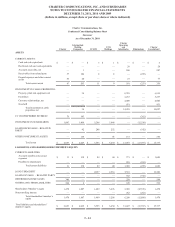Charter 2011 Annual Report Download - page 119
Download and view the complete annual report
Please find page 119 of the 2011 Charter annual report below. You can navigate through the pages in the report by either clicking on the pages listed below, or by using the keyword search tool below to find specific information within the annual report.
CHARTER COMMUNICATIONS, INC. AND SUBSIDIARIES
NOTES TO CONSOLIDATED FINANCIAL STATEMENTS
DECEMBER 31, 2011, 2010 AND 2009
(dollars in millions, except share or per share data or where indicated)
F- 35
Basic earnings per share
Effect of Class B common stock
CII warrants
Diluted earnings per share
Successor
One Month Ended December 31, 2009
Earnings
$ 2
—
—
$ 2
Shares
112,078,089
212,923
2,055,849
114,346,861
Earnings Per
Share
$ 0.02
—
—
$ 0.02
The shares of Class B common stock held by Mr. Allen had a 35% voting interest in Charter, on a fully diluted basis, and were
exchangeable at any time on a one-for-one basis for shares of Charter Class A common stock. The CII warrants represent shares
resulting from the exercise of warrants held by CII. See Note 23.
The 1.3 million Charter Holdings warrants and 6.4 million CIH warrants were not included in the computation of diluted earnings
per share because their exercise prices were greater than the average market price of the common shares. Restricted stock was
also not included in the computation of diluted earnings per share because the effect would have been antidilutive.
Basic earnings per share
Effect of CII Class B Charter Holdco units
Effect of Vulcan Class B Charter Holdco units
Effect of 5.875% convertible senior notes due 2009
Effect of CCHC note
Effect of 6.50% convertible senior notes due 2027
Diluted earnings per share
Predecessor
Eleven Months Ended November 30, 2009
Earnings
$ 11,364
—
—
—
1
8
$ 11,373
Shares
378,784,231
222,818,858
116,313,173
1,287,190
42,282,098
140,581,566
902,067,116
Earnings Per
Share
$ 30.00
(11.11)
(3.06)
(0.03)
(0.87)
(2.32)
$ 12.61
Prior to the Effective Date, CII Class B Charter Holdco units and Vulcan Class B Charter Holdco units represented membership
units in Charter Holdco, held by entities controlled by Mr. Allen, that were exchangeable at any time on a one-for-one basis for
shares of Charter Class B common stock, which were in turn convertible on a one-for-one basis into shares of Charter Class A
common stock. The 5.875% convertible senior notes due 2009 and 6.50% convertible senior notes due 2027 represent the shares
resulting from the assumed conversion of the notes into shares of Charter’s Class A common stock. The CCHC note represented
the shares resulting from the assumed conversion of the note into Charter Holdco units that were exchangeable on a one-for-one
basis for shares of Charter Class B common stock, which were in turn convertible on a one-for-one basis into shares of Charter
Class A common stock.
All options to purchase common stock, which were outstanding during the eleven months ended November 30, 2009, were not
included in the computation of diluted earnings per share because the options’ exercise price was greater than the average market
price of the common shares. All restricted stock and performance units were also not included in the computation of diluted
earnings per share because the effect would have been antidilutive.


